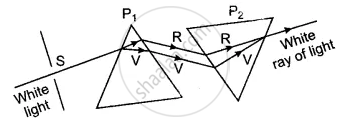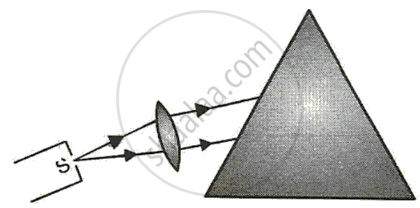Advertisements
Advertisements
प्रश्न
Comment on the statement: ‘When any ray of white light is incident on a glass prism, it simply disperses it into its seven constituent colours.
उत्तर
Before making any comment, the following simple experiment should be performed.

Arrangement is shown in the diagram. P1 and P2 are two glass prisms exactly similar and placed at some distance from each of the such that their refracting surfaces are parallel to each other and the base of the prism P2 is upwards and vertex downwards. S is a narrow slit through which a ray of white light is incident on the refracting face of the prism P1. It is dispersed by it into its seven constituent colours.
When this dispersed light falls on the refracting surface of the prism P2, having its base upwards so that the rays have deviated in a direction different from the first, we see on the screen only a white spot of light. It is evident that the second prism P2 recombines these colours to form white light acting as a ‘recombination prism’ while the first prism acts as a ‘dispersing prism’.
APPEARS IN
संबंधित प्रश्न
Name three factors on which the deviation produced by a prism depends and state how does it depend on the factors stated by you.
Write the approximate wavelengths for blue.
Fig shows part of the arrangement for obtaining pure spectrum.
(a) Complete thediagram and show how to obtain a pure spectrum.
(b) What are the conditions necessary for obtaining a pure spectrum?

Give a reason, why the violet colour of white light deviated most and red colour of white light deviated least.
What is understood by the term dispersion of light? What is its cause?
Explain, why quartz prism is required for obtaining the spectrum of ultra-violet light?
A prism causes dispersion of white light while a rectangular glass block does not. Explain.
Draw a neat diagram to show the arrangement you would use to project a pure spectrum of white light on a screen.
